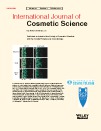Bioadhesive hydrogels for cosmetic applications
Dublin Core
Título
Tema
Abstract
Introduction
The use of bioadhesive hydrogels for skin care presents important advantages such as long residence times on the application site and reduced product administration frequency.
Object
The aim of the present work was to develop bioadhesive hydrogels for skin application, using caffeine as a model active ingredient.
Methods
Eight hydrogels were formulated using binary combinations of a primary polymer (carbomer homopolymer type C (Carbopol® 980) or kappa carrageenan potassium salt (Gelcarin® GP-812 NF)) and a secondary polymer (carbomer copolymer type B (Pemulen™ TR-1), xanthan gum or guar gum). Hydrogels were characterized by means of physico-chemical (dynamic rheological measurements, spreadability and adhesion measurements) and sensory methods (projective mapping in combination with a check-all-that-apply (CATA) question). Caffeine hydrogels were formulated using two of the most promising formulations regarding adhesion properties and sensory characteristics. In vitro active ingredient release studies were carried out.
Results
Hydrogel formulations showed a prevalently elastic rheological behaviour. Complex viscosity of carbomer homopolymer type C hydrogels was higher than that of the kappa carrageenan hydrogels. Besides, complex viscosity values were dependent on the secondary polymer present in the formulation. Significant differences among hydrogels were found in detachment force, work of adhesion and spreading diameter results. Association of projective mapping with CATA allowed to determine similarities and dissimilarities among samples. Cluster analysis associated the samples in two groups. Two hydrogels were selected to study the release of caffeine. Both hydrogels presented similar release profiles which were well described by the Higuchi model. Caffeine release was exclusively controlled by a diffusive process.
Conclusion
Physico-chemical and sensory techniques enabled the identification of bioadhesive hydrogel formulations with positive characteristics for cosmetic applications. Formulations which combined carbomer homopolymer type C with xanthan gum or with carbomer copolymer type B were the most promising for bioadhesive skin products. Caffeine release profiles of selected formulations were not statistically different. Both hydrogels gradually released the active ingredient, reaching approximately 80% within the first 5 h, and their profiles were well described by the Higuchi model. In this context, it could be concluded that the selected hydrogels are suitable bioadhesive hydrogel formulations for cosmetic application on the skin.
Fuente
Editor
Fecha
Derechos
Información sobre Derechos de Autor
(Por favor lea este aviso antes de abrir los documentos u objetos)
La legislación uruguaya protege el derecho de autor sobre toda creación literaria, científica o artística, tanto en lo que tiene que ver con sus derechos morales, como en lo referente a los derechos patrimoniales con sujeción a lo establecido por el derecho común y las siguientes leyes
(LEY 9.739 DE 17 DE DICIEMBRE DE 1937 SOBRE PROPIEDAD LITERARIA Y ARTISTICA CON LAS MODIFICACIONES INTRODUCIDAS POR LA LEY DE DERECHO DE AUTOR Y DERECHOS CONEXOS No. 17.616 DE 10 DE ENERO DE 2003, LEY 17.805 DE 26 DE AGOSTO DE 2004, LEY 18.046 DE 24 DE OCTUBRE DE 2006 LEY 18.046 DE 24 DE OCTUBRE DE 2006)
ADVERTENCIA - La consulta de este documento queda condicionada a la aceptación de las siguientes condiciones de uso: Este documento es únicamente para usos privados enmarcados en actividades de investigación y docencia. No se autoriza su reproducción con fines de lucro. Esta reserva de derechos afecta tanto los datos del documento como a sus contenidos. En la utilización o cita de partes debe indicarse el nombre de la persona autora.
Formato
Idioma
Tipo
Identificador
Document Item Type Metadata
Original Format
- Fecha de agregación
- March 10, 2016
- Colección
- Bibliografía Nacional Química
- Tipo de Elemento
- Document
- Etiquetas
- Cosméticos, Hidrogeles
- Citación
- Parente, María Emma, “Bioadhesive hydrogels for cosmetic applications,” RIQUIM - Repositorio Institucional de la Facultad de Química - UdelaR, accessed August 25, 2024, https://riquim.fq.edu.uy/items/show/3748.
- Archivos

